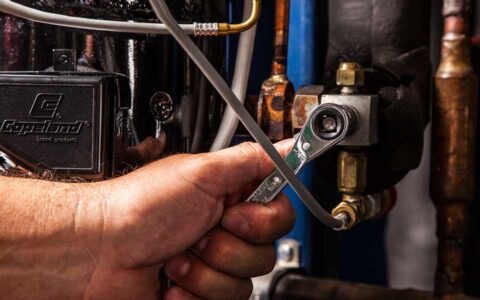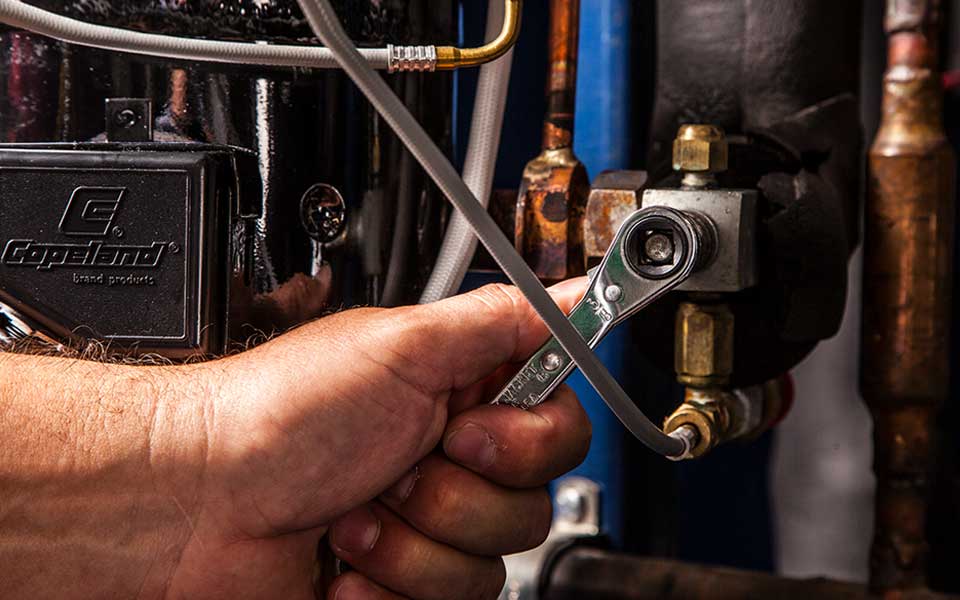Servicing the next generation of lower-GWP refrigerants

*On June 1, 2023 Emerson’s Climate Technologies business became a new standalone company – Copeland. Though our name has changed, we are building on more than a century of HVACR innovation and industry leadership, and Copeland continues to offer the same products, industry stewardship, and learning opportunities you’ve grown to trust. Information found on this webpage posted before June 1, 2023 may contain our old name or branding, but you can be at ease knowing it was created with the knowledge and expertise of Copeland.
As the phasedown of hydrofluorocarbon (HFC) refrigerants ramps up over the next several years, technicians can expect to see a wider variety of refrigeration architectures that use lower-global warming potential (GWP) alternatives.

As I detailed in a recent article for Engineered Systems, these emerging refrigerant substitutes have unique properties and characteristics compared to legacy HFCs, which impact system design and servicing considerations.
To navigate this evolving landscape, service technicians should educate themselves on the fundamentals of working with the next generation of lower-GWP refrigerants. Despite critical differences and refrigerant-specific nuances, most long-held and widely adopted servicing best practices still apply.
Working with the next generation of lower-GWP refrigerants will require familiarity with already approved substitutes — namely, CO2 (R-744) and R-290 (propane) — and a new class of A2L alternatives.
As each refrigerant is poised to play unique and specific roles within commercial refrigeration, it’s important to understand their respective potential impacts on system servicing and adhere to the UL 60335-2-89, 2nd edition requirements, if applicable.
Expanded potential for R-290
In most stand-alone equipment, R-290 systems are critically charged and hermetically sealed at the manufacturer’s facility. Malfunctioning units are typically refurbished by a qualified technician and/or reconditioning company. If servicing is required, it’s important to follow R-290 servicing procedures.
Before entering a service area, use a portable gas monitor that can alert you to the presence of R-290 in the air. Always wear the required personal protective equipment (PPE) to ensure safety. Brazing should be performed only by qualified personnel and under specific precautionary conditions. Check all brazing and silver soldering equipment for leaks and proper pressure settings.
Refrigerant must first be evacuated with a vacuum pump and purged from system lines with an inert gas (e.g., nitrogen). Before working on a stand-alone, R-290 system, it should be moved to an unconfined, unoccupied and well-ventilated area. If possible, place a fan in the room to ensure active ventilation.
Understanding A2L systems and safety standards
Lower-flammability A2Ls are well on the path to regulatory approval and poised to fill expanded roles across a broad spectrum of commercial refrigeration systems. From both servicing and safety perspectives, A2Ls follow guidelines established in the UL 60335-2-89, 2nd edition safety standard.
Each A2L refrigerant has a unique lower flammability limit (LFL) rating, which is used to calculate charge limits. For example: the LFL of R-454C is 0.293 grams per cubic meter (g/m3). LFL is based on the worst-case formulation (WCF), as defined in ASHRAE 34.
When servicing an A2L system, the first step is to identify which A2L refrigerant is being used. Look for refrigerant labels on the system and red markings on all service fittings; and clearly mark fittings for future servicing. Use only A2L-certified gauges, vacuum pumps, and leak detection and refrigerant recovery machines.
Servicing A2Ls requires additional steps that are already considered industry-accepted best practices: evacuate, purge and test for leaks. If possible, try to work in a well-ventilated area using a continuous leak monitoring and detection system.
Braze all connections before embarking on higher-risk activities and be aware of your servicing space, including the presence of other people or potential hazards. For the most part, typical A1 system best practices are required on A2L systems.
Note: it’s important to use only A2L-qualified components and controls, and only charge systems according to their designed charge limits.
CO2 characteristics and considerations
Compared to traditional HFC-based systems, CO2 (R-744) has unique servicing considerations — high system pressures, a low critical point and high triple point — impacting refrigerant storage, system charging and other key servicing requirements.
Because CO2 tanks are designed to handle its high pressures, they weigh significantly more than standard HFC tanks — potentially up to nearly 200 lbs. A full charge of a 2,000-lb. system may require 40 cylinders weighing 8,000 lbs. (i.e., 4 tons). Technicians will need to plan for storing reserve refrigerant and be aware that storing high quantities of CO2 will affect building codes.
System charging is an especially important consideration with CO2 systems, primarily because liquid R-744 will turn to dry ice if the system reaches the triple point pressure of 60.4 psig. To avoid this, charge with vapor until system pressures exceed the triple point pressure — typically beyond 100 lbs. psig — then finish charging with liquid.
CO2’s coefficient of expansion (COE) is higher than a typical HFC, which can cause pressure to rise rapidly when liquid refrigerant gets trapped in between two valves. Pressure can increase 145 psig for every 1.8 °F increase in temperature. Many systems are fitted with appropriate pressure-relief valves at the location of the trapped liquid to prevent pressure rise and assist with system servicing.
Leak detection is also an important consideration for maximizing the performance and safety of CO2 systems. R-744 is colorless, odorless and heavier than air — and can be potentially toxic in high concentrations. Leak detectors should be mounted 18 inches off the ground and below the breathing level. Early detection can prevent CO2 system performance issues and protect food quality.
To learn more about servicing best practices for A3, A2L, and CO2 refrigerants, please visit the contractor training section of our content hub.

8 proven strategies for rigorous cold chain management
by Dan Knauer | Cold Chain
Preparing for the approval and safe use of A2Ls in commercial refrigeration applications...
Protection for high-value shipments just got even better
by Alex Axelsson | Cold Chain, Transportation
We’re excited to announce the release of Copeland’s newest real-time tracker, the GO Real-Time...

Three proven strategies to prevent cargo theft
by Chris Lafferty | Cold Chain, Transportation
The over-the-road (OTR) transport industry is experiencing a surge in cargo thefts. As thieves...
The post Servicing the Next Generation of Lower-GWP Refrigerants appeared first on Copeland.